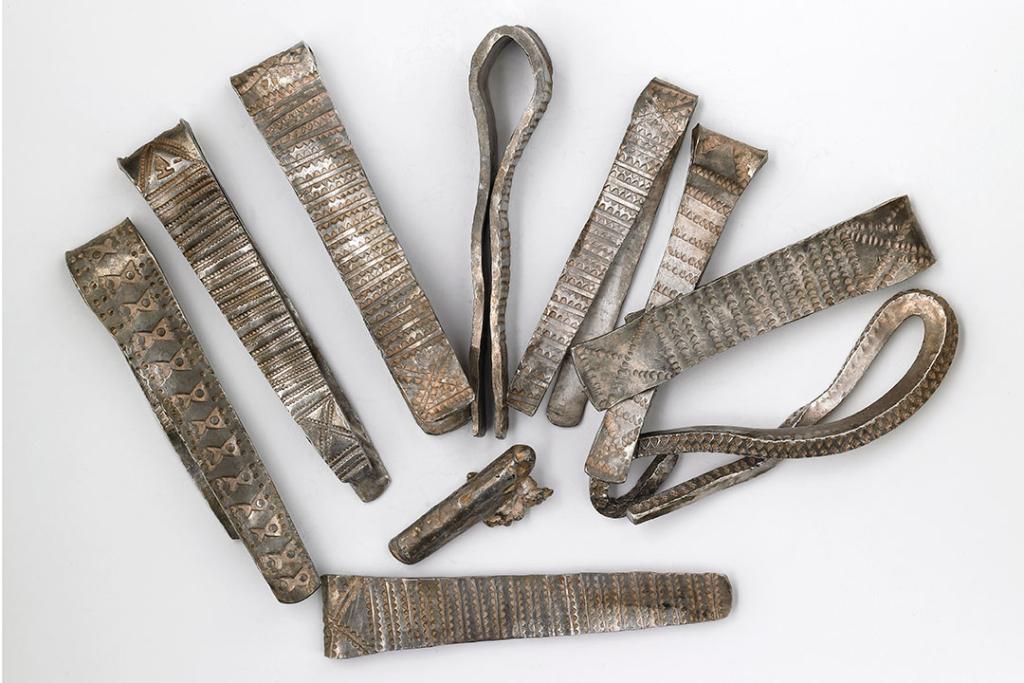Vikings show their metal!
Dr Matthew Ponting is a specialist in the scientific analysis of archaeological metalwork. He has analysed several items from the Museum of Liverpool collection, and made some fascinating discoveries about the origins of the Huxley Hoard, which he shares with us here.

I’ve been delighted to work with the Museum of Liverpool to study the Huxley Hoard, which is an important assemblage of Viking silver objects. It consists of 21 arm rings, plus one silver ingot and numerous fragments of lead, thought to be the remnants of a container. These artefacts were found by a metal-detectorist in 2004.
It’s relatively rare for scientists to have the opportunity to analyze objects like this. But scientific analysis can tell us some really fascinating things about objects. Previous analysis of Viking silver from Birka, Sweden found that the chemical composition of the metal was particularly similar to that of Arabic coins, dirhams. These are found in significant numbers in Viking Scandinavia, pointing to Viking links with the Middle East. An ongoing project, Silver and the Origins of the Viking Age, is analysing many groups of Viking silver and starting to reveal the fascinating complexity in the use and circulation of silver during the Viking period.

Decorated arm ring, accession number 2007.5.2
Analysis of the Huxley Hoard
Five silver objects were selected for analysis and including two decorated arm rings (2007.5.2, 2007.5.8), two plain arm rings, (2007.5.19 and 2007.5.20) and the small silver ingot (2007.5.22). Small samples of metal were removed from each object by drilling into an inconspicuous location with a 0.8 mm diameter steel drill and collecting the turnings. By dissolving these in a chemical solution and then spinning that rapidly in a centrifuge all the different components of the metal separate out, and the makeup of the different metals gives a telltale signature which hints at its source.

Undecorated arm ring, accession number 2007.5.19
What the analysis revealed
The chemical analysis reveals that the silver of the Huxley Hoard is, in fact, a metal alloy of a mixture of silver, with some copper, and small amounts of lead (0.5% - 1.2%) and gold (0.4% - 0.8%). In the mixture are also traces of arsenic, bismuth, cobalt, iron, nickel, antimony, tin and zinc.

Table showing the metal composition of the objects analysed
The armbands
From the four samples taken, there are significant differences between the decorated and plain arm rings in the Huxley Hoard. The two decorated arm-rings contain relatively high levels of gold (> 0.5%) and low levels of bismuth (<0.04%), whilst the two plain arm-rings exhibit the opposite trend, having relatively low gold (< 0.4%) and higher bismuth (> 0.06%). Gold and bismuth are the two trace elements found in silver ores that largely retain their original concentrations throughout smelting and refining and as such can be used to characterize types of silver. These different characteristics of the decorated and plain arm rings suggest that the silver used to make the two types had different origins. This is confirmed by analysis of the traces of lead in the different arm bands, which also varies between the decorated and the plain.
The ingot

Silver ingot, accession number 2007.5.22
The small ingot stands out as its metal composition is significantly different to all four arm rings. It has higher levels of bismuth and lower levels of gold. This difference suggests that the silver from which the ingot was made originated from a different source to that used to make the arm rings. The lead in the ingot was also quite different to that in the arm rings.

Lead isotope plot of the Huxley objects compared with objects from Hedeby, Denmark (Merkel 2016), Islamic Dirhams (Standish et al. 2021) and slags from the important silver production site at Melle, France (Bompaire and Guillaume 2018). The Huxley ingot, labelled, clearly stands out as being more like Islamic coins.
The compositions tell the story of where the silver has been obtained. It has been suggested that a switch from mines in Iraq/Iran to mines in Central Asia and Afghanistan at some point between the end of the 9th and beginning of the 10th century could account for some differences in silver: some being silver from older sources other more recently mined ores.

Decorated arm ring, accession number 2007.5.8
The lead sheet
The composition of both pieces is essentially the same, being made of pure ‘soft’ lead. The term ‘soft’ lead is used to describe lead that is relatively pure and low in trace elements. This makes it particularly soft and ductile and was thus the type of lead traditionally preferred for construction purposes, coffins, water pipes and tanks. Sources of ore that produce such lead are relatively common in Britain, but it is perhaps significant that Huxley is close to lead sources in North Wales that are known to yield similarly pure lead metal.
What have we learned?
Our understand of the Viking economy and of the movement and use of silver in particular is developing. This analysis of the Huxley Hoard contributes to that. The emerging picture is one of fluid complexity with silver sources changing, and also of a system of supply through a series of traders where eastern silver from a variety of sources was recycled into other artefacts (often coins) before ended up in Scandinavia and Western Europe where further re-cycling and mixing took place.
This project has contributed to the overall picture of Viking silver use and recycling, and has revealed some surprises. The suggestion that different styles of arm-ring may be made of different types of silver is particularly intriguing and may hint at a more complex meaning behind these artefacts, we are always learning more about objects in the collection and they still have more of their stories to reveal!

